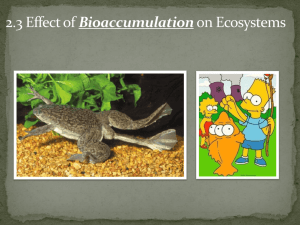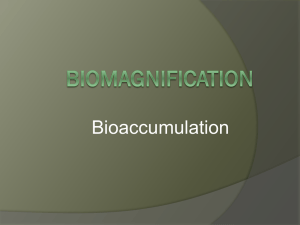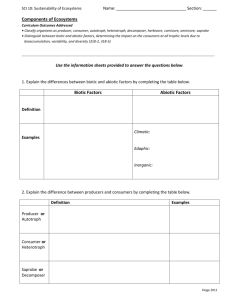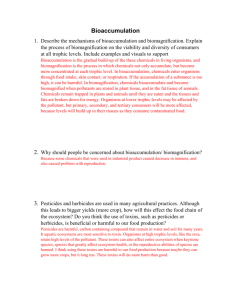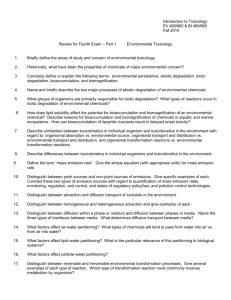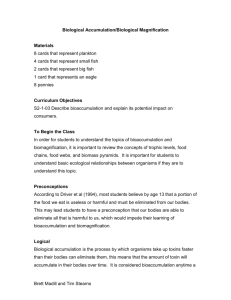S2-1-03 - Bioaccumulation - Lesson
advertisement
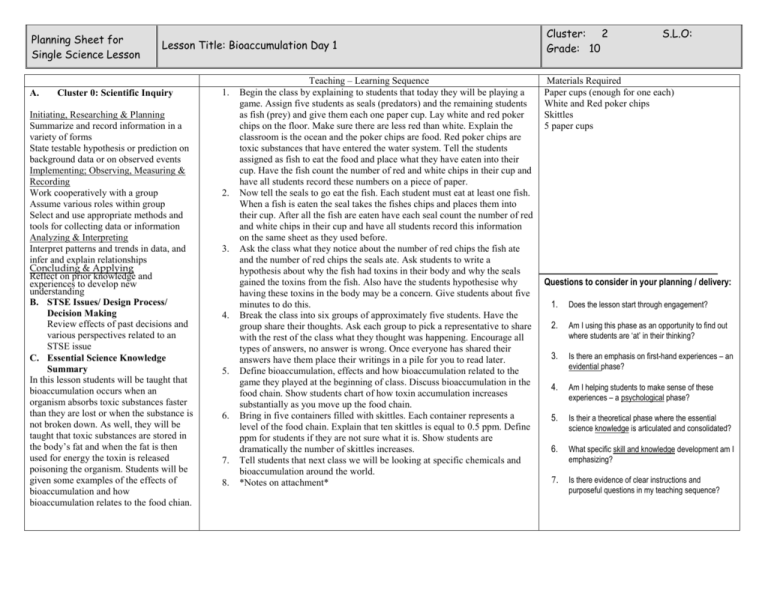
Planning Sheet for Single Science Lesson A. Lesson Title: Bioaccumulation Day 1 Cluster 0: Scientific Inquiry Initiating, Researching & Planning Summarize and record information in a variety of forms State testable hypothesis or prediction on background data or on observed events Implementing; Observing, Measuring & Recording Work cooperatively with a group Assume various roles within group Select and use appropriate methods and tools for collecting data or information Analyzing & Interpreting Interpret patterns and trends in data, and infer and explain relationships Concluding & Applying Reflect on prior knowledge and experiences to develop new understanding B. STSE Issues/ Design Process/ Decision Making Review effects of past decisions and various perspectives related to an STSE issue C. Essential Science Knowledge Summary In this lesson students will be taught that bioaccumulation occurs when an organism absorbs toxic substances faster than they are lost or when the substance is not broken down. As well, they will be taught that toxic substances are stored in the body’s fat and when the fat is then used for energy the toxin is released poisoning the organism. Students will be given some examples of the effects of bioaccumulation and how bioaccumulation relates to the food chian. 1. 2. 3. 4. 5. 6. 7. 8. Teaching – Learning Sequence Begin the class by explaining to students that today they will be playing a game. Assign five students as seals (predators) and the remaining students as fish (prey) and give them each one paper cup. Lay white and red poker chips on the floor. Make sure there are less red than white. Explain the classroom is the ocean and the poker chips are food. Red poker chips are toxic substances that have entered the water system. Tell the students assigned as fish to eat the food and place what they have eaten into their cup. Have the fish count the number of red and white chips in their cup and have all students record these numbers on a piece of paper. Now tell the seals to go eat the fish. Each student must eat at least one fish. When a fish is eaten the seal takes the fishes chips and places them into their cup. After all the fish are eaten have each seal count the number of red and white chips in their cup and have all students record this information on the same sheet as they used before. Ask the class what they notice about the number of red chips the fish ate and the number of red chips the seals ate. Ask students to write a hypothesis about why the fish had toxins in their body and why the seals gained the toxins from the fish. Also have the students hypothesise why having these toxins in the body may be a concern. Give students about five minutes to do this. Break the class into six groups of approximately five students. Have the group share their thoughts. Ask each group to pick a representative to share with the rest of the class what they thought was happening. Encourage all types of answers, no answer is wrong. Once everyone has shared their answers have them place their writings in a pile for you to read later. Define bioaccumulation, effects and how bioaccumulation related to the game they played at the beginning of class. Discuss bioaccumulation in the food chain. Show students chart of how toxin accumulation increases substantially as you move up the food chain. Bring in five containers filled with skittles. Each container represents a level of the food chain. Explain that ten skittles is equal to 0.5 ppm. Define ppm for students if they are not sure what it is. Show students are dramatically the number of skittles increases. Tell students that next class we will be looking at specific chemicals and bioaccumulation around the world. *Notes on attachment* Cluster: 2 Grade: 10 S.L.O: Materials Required Paper cups (enough for one each) White and Red poker chips Skittles 5 paper cups Questions to consider in your planning / delivery: 1. Does the lesson start through engagement? 2. Am I using this phase as an opportunity to find out where students are ‘at’ in their thinking? 3. Is there an emphasis on first-hand experiences – an evidential phase? 4. Am I helping students to make sense of these experiences – a psychological phase? 5. Is their a theoretical phase where the essential science knowledge is articulated and consolidated? 6. What specific skill and knowledge development am I emphasizing? 7. Is there evidence of clear instructions and purposeful questions in my teaching sequence? Planning Sheet for Single Science Lesson Lesson Title: Bioaccumulation Day 1 Teaching – Learning Sequence Cluster: 2 Grade: 10 S.L.O: Materials Required A. Cluster 0: Scientific Inquiry Initiating, Researching & Planning Implementing; Observing, Measuring & Recording Analyzing & Interpreting Concluding & Applying B. STSE Issues/ Design Process/ Decision Making Questions to consider in your planning / delivery: 1. Does the lesson start through engagement? C. Essential Science Knowledge Summary In this lesson students will be taught that 2. Am I using this phase as an opportunity to find out where students are ‘at’ in their thinking? 3. Is there an emphasis on first-hand experiences – an evidential phase? Will you assess? If so, what? Their knowledge about toxins in the body and any previous knowledge about bioaccumulation. 4. Am I helping students to make sense of these experiences – a psychological phase? 5. Is their a theoretical phase where the essential science knowledge is articulated and consolidated? How will you assess it? I will give students formative feedback on their hypothesis of why the seals had more toxins in their systems than the fish and the possible effects of bioaccumulation. 6. What specific skill and knowledge development am I emphasizing? 7. Is there evidence of clear instructions and purposeful questions in my teaching sequence? Planning Sheet for Single Science Lesson Lesson Title: Bioaccumulation Day 2 Teaching – Learning Sequence Cluster: 2 Grade: 10 S.L.O: Materials Required A. Cluster 0: Scientific Inquiry 1. Initiating, Researching & Planning Select and integrate information obtained from a variety of sources Summarize information in a variety of forms Implementing; Observing, Measuring & Recording Assume the responsibilities of various roles within a group Analyzing & Interpreting Identify and suggest explanations for discrepancies in data Concluding & Applying Draw a conclusion that explains investigation results B. STSE Issues/ Design Process/ Decision Making Review effects of past decisions and various perspectives related to an STSE issue C. Essential Science Knowledge Summary In this lesson students will be taught that bioaccumulation affects people and animals all over the world by reading an article and discussing with fellow students. Students will be taught about mercury, lead, DDT, PCB’s and dioxins and their effects on the environment. Will you assess? If so, what? I will assess the posters that the students will be required to make. How will you assess it? I will mark the poster for correct information and if they researched any connection to Winnipeg 2. 3. 4. 5. 6. 7. 8. Students will enter the class to find that three different articles about cases of bioaccumulation have been distributed throughout the room. Students will be instructed to sit quietly, take out a pen or pencil, put their binders away and read the article that they have in their spot. When they are finished reading have the student answer the following questions on the back of the sheet. (Have the questions written on the board or overhead) 1) What does bioaccumulation mean? 2) How does bioaccumulation affect us here in Winnipeg? Since the articles are quite graphic in regards to bioaccumulation the idea is that students will be engaged and excited to discuss their article. Break the students off into groups of three, a member for each article. Have the members of the group share with the others the contents of their article. Give the students 10 minutes to talk. Ask students to return to their desks and ask if anyone wants to share their opinion or has a comment. Discuss the questions answered on the back of the article. During this discussion listen to how the students describe bioaccumulation in their own words, guide students to correct answers if needed. Ask the students to identify the chemicals mentioned in their articles that are causing toxic effects. Explain to student the uses of mercury, lead, DDT, PCB’s and dioxins by humans. This will be accompanied by notes. Now that students have been taught what bioaccumulation, how it affects humans and animals and some of the chemicals involved students will partner up and create a poster about a particular animal or chemical and how it relates to bioaccumulation. Explain that many of the chemicals discussed have specific effects on certain animals and that may be something they want to research. For example the shells of bald eagles. Explain there has been a decline in bald eagle population due to this. They will also be required to research if their topic has any connection to Winnipeg and recommendations for solutions (i.e. is there something environment friendly we can use instead). Students will be given the last half an hour to work at the library to get started on their poster. Posters will be due two classes later and will be presented. Articles Book computer lab/library Questions to consider in your planning / delivery: 1. Does the lesson start through engagement? 2. Am I using this phase as an opportunity to find out where students are ‘at’ in their thinking? 3. Is there an emphasis on first-hand experiences – an evidential phase? 4. Am I helping students to make sense of these experiences – a psychological phase? 5. Is their a theoretical phase where the essential science knowledge is articulated and consolidated? 6. What specific skill and knowledge development am I emphasizing? 7. Is there evidence of clear instructions and purposeful questions in my teaching sequence? Bioaccumulation Notes for Day One: BOLD Writing – Instructions for teachers Regular writing – Notes to give students What is bioaccumulation? Bioaccumulation is a process in which chemicals build up (accumulate) in the fatty tissue and become more concentrated with each link in the food chain. This occurs either because the chemical is taken up faster than it is used or because the chemical cannot be metabolized (broken down) by the organism. If the chemical is able to be metabolized each time the organism burns fat for energy the toxin is released poisoning the organism. These chemicals come from many sources (ask the students to give some examples of sources), such as pesticides, automobiles, industrial factories and dumping. This means that for each trophic level of the food chain (example: small fish to large fish) the amount of chemical in the body increases. DDT concentration increases of 10 million times 25 ppm in fisheating birds 2 ppm in large fish 0.5 ppm in small fish 0.04 ppm in zooplankton 0.000003 ppm in water One ppm = the number of "parts" by weight of a substance per million parts of water Example 1lb of chlorine in 1 million lbs. of water Set up the skittle cups. You will need 5 paper cups. Label each to correspond with a level of the food chain (i.e. water, zooplankton etc.) Since one skittle will represent 0.05 ppm, for the first two cups you will have to break off little pieces. The third cup will have one skittle, the fourth cup 4 skittles and the fifth cup 50 skittles. Show students the cups and have the pull out the data they recorded from the game. Do they see any connections? How does all this information relate to our game? In our game the fish were being eating by seals and we noticed that the amount of chemicals being carried in the seals fat was much higher than in the fish. This is similar to the chart. Why might this be a problem? For many organisms and animals this causes problems with development, reproduction, organ function etc. Scientists have been noticing that bioaccumulation has specifically been causing growth inhibition, high mortality of larvae and embryos, softening of egg shells (explain how birds will crush their own eggs when they incubate them), developmental deformities and infertility. These are just a few of the possible effects of bioaccumulation. Share with students that next class we will be looking at specific chemicals. Bioaccumulation Notes for Day Two: Mercury: Used in thermometers, barometers, mascara, some dentistry Mad Hatter- mid 18th – 19th century, animal pelts soaked in mercuric nitrate to separate the fur from the pelt Harmful if inhaled, may be absorbed through skin, may cause central nervous system effects, causes reproductive and fetal effects Bacteria at bottom of river convert the waste to methyl mercury that then accumulates in tissues of organisms Held tightly to fish protein Poisoning from fish Lead Used in building construction, lead-acid batteries (used in vehicles), pipes, paint, fishing weights Toy recall – lead paint Potent neurotoxin (paralyzes nerve), accumulates in bone and soft tissue over time (brain, kidney) DDT Used to kill mosquitoes during WWII to prevent malaria and typhus among soldiers After war was used as pesticide, banned in 1972 after the book Silent Spring, was not outlawed until 1994, still used in some malaria prone countries Lead to decline of bald eagle, effects hardness of shell Soluble in lipids, collects in fatty tissues Reproductive effects, cancer, birth defects PCB Used in PVC coating for electrical wires, flame retardants, wood floor finishes, paints, carbonless copy paper Absorbed through air, food, water, breast milk Enter body and are stored in fatty tissue Can leave blood and enter tissue and transformed to be excreted Can lead to cancer, reduced fertility Banned in 1970’s Dioxins Toxic chemical found in environment Chemical skeleton, contains chlorine Come from the production of steel and iron, burning of household waste (plastics), fuel burning, tobacco smoke, wood burning Carried through the air Mostly taken in from food and stored in body fat Causes skin disorders, liver problems, impairment of immune system, reproductive functions, effects on development, cancer ARTRICLES FOR DAY 2: Retrieved from http://www.american.edu/TED/MINAMATA.HTM on September 30, 2008. In 1907 the villagers of Minamata convinced the founder of Chisso Corporation to build a factory in their town, hoping to benefit from the wealth of industrialization. The owner, Jun Noguchi agreed to the development, but used the people from Minamata as simple factory workers The more elite positions, such as engineers and managers were "imported" as he termed it, from the finest universities, like Tokyo University. By 1925, the Chisso Corporation was dumping waste into Minamata Bay and destroying the fishing areas. The theory behind Noguchi's industry was to pay off the Minamata fisherman in exchange for damaging their fishing environment. According to Eugene Smith's interview of the people who lived in Minamata, the company believed that it was much cheaper to pay off the few people who were opposed to the dumping, rather than implement an environmentally safe technique of waste removal. Therefore, since the villagers accepted this practice through compensation of money, and the government was behind the industry, the entire process appeared ethical. Chisso Corporation started developing plastics, drugs, and perfumes through the use of a chemical called acetaldehyde in 1932. Acetaldehyde is produced using mercury as a compound, and was key component in the production of their products. The company was considered an economic success in Japan, particularly because it was one industry that maintained development despite Japan's suffering throughout and right after W.W.II. As other companies economically ripened during Japan's postwar period, so did the Chisso Corporation. Sales augmented with Japan's economic success. In addition, Chisso Corporation's sales increased dramatically, considering Chisso was the only manufacturer of a primary chemical called D.O.P, a plasticizer (diotyl phthalate). Having a monopoly on the chemical enabled Chisso to expand rapidly. Since Chisso Corporation was the main industry in the small Minamata town, the town's growth period from 1952 to 1960 paralleled Chisso's progress. Not until the mid-1950's did people begin to notice a "strange disease". Victims were diagnosed as having a degeneration of their nervous systems. Numbness occurred in their limbs and lips. Their speech became slurred, and their vision constricted. Some people had serious brain damage, while others lapsed into unconsciousness or suffered from involuntary movements. Furthermore, some victims were thought to be crazy when they began to uncontrollably shout. People thought the cats were going insane when they witnessed "suicides" by the cats. Finally, birds were strangely dropping from the sky. Series of these unexplainable occurrences were bringing panic to Minamata. Dr. Hajime Hosokawa from the Chisso Corporation Hospital, reported on May 1, 1956 that, "an unclarified disease of the central nervous system has broken out". Dr. Hosokawa linked the fish diets to the disease, and soon investigators were promulgating that the sea was being polluted by poisons from the Chisso Corporation. Retrieved from http://www.arctic.noaa.gov/essay_calder.html on September 30, 2008. Persistent Organic Pollutants in the Arctic Extracted from "Arctic Pollution Issues: A State of the Arctic Environment Report", prepared by the Arctic Monitoring and Assessment Program (AMAP) of the intergovernmental Arctic Council by Dr. John Calder, Director of NOAA's Arctic Research Office. Stiff and lean after six months curled in a den, a female polar bear squeezes herself out of her winter home. Two small cubs emerge tentatively at her heel for their first view of the world beyond a snow cave. Entirely dependent on their mother, the cubs follow obediently. Having used up most of her fat stores, the female scans the sea ice below and ponders a meal of seal blubber. But her cubs are not yet ready to travel, and her milk will have to sustain them for some time to come. The milk is rich and nourishing but today it also harbors a threat. Chemicals from lands far beyond her sea-ice domain taint the seals that the mother has feasted on in the past, and will need again soon. The chemicals that bind to the fat of the seals have accumulated in her own fat stores. Unwittingly, the mother passes the toxins to her young in her fat-rich milk, with effects that are still unclear. Courtesy of Polar Bears Alive, Copyright © 1997, 1998, 1999, Polar Bears Alive. In 1945, a booming chemical industry launched a new, effective tool for dealing with insect pests: DDT. It held great promise, Photographs are © Dan including the hope of saving crops and eradicating disease-carrying insects. Twenty years later, DDT and other similar chemicals Guravich. For more had indeed benefited agriculture and relieved some of the problems associated with insects in many areas of the world. information, please contact However, these gains came at a price, as DDT is toxic to many more organisms than those it was intended to kill. In particular, Polar Bears Alive. Persistent Organic Pollutants (POPs): A Background birds of prey had trouble reproducing, and their populations declined in many polluted parts of the world. As early as 1970, when it was detected in the blubber of ringed seals, it was evident that DDT was present in the Arctic. By the mid-1970s, DDT and other pesticides had been detected in beluga whale, polar bear, and fish. Moreover, birds of prey declined in northern areas that were thought to be uncontaminated. In addition to pesticides, most tests of animals also found traces of industrial oil made of chemicals known as PCBs. By 1980, there was evidence that these chemicals had reached the Arctic via long-range transport. In the late 1980s, there was evidence that human mother's milk at a location in the Northwest Territories of Canada contained enough PCBs to cause concern about effects on human health. The most likely source was the food the woman had eaten. Retrieved from http://www.nytimes.com/2005/01/09/magazine/09TOXIC.html?pagewanted=1&_r=1&oref=slogin on September 30, 2008. Toxic Breast Milk? By FLORENCE WILLIAMS Published: January 9, 2005 If human breast milk came stamped with an ingredients label, it might read something like this: 4 percent fat, vitamins A, C, E and K, lactose, essential minerals, growth hormones, proteins, enzymes and antibodies. In a healthy woman, it contains 100 percent of virtually everything a baby needs to survive, plus a solid hedge of extras to help ward off a lifetime of diseases like diabetes and cancer. Breast milk helps disarm salmonella and E. coli. Its unique recipe of fatty acids boosts brain growth and results in babies with higher I.Q.'s than their formula-slurping counterparts. Nursing babies suffer from fewer infections, hospitalizations and cases of sudden infant death syndrome. For the mother, too, breast-feeding and its delicate plumbing of hormones afford protection against breast and ovarian cancers and stress. Despite exhaustion, the in-laws and dirty laundry, every time we nurse our babies, the love hormone oxytocin courses out of our pituitaries like a warm bath. Human milk is like ice cream, Valium and Ecstasy all wrapped up in two pretty packages. But read down the label, and the fine print, at least for some women, sounds considerably less appetizing: DDT (the banned but stubbornly persistent pesticide famous for nearly wiping out the bald eagle), PCB's, dioxin, trichloroethylene, perchlorate, mercury, lead, benzene, arsenic. When we nurse our babies, we feed them not only the fats, sugars and proteins that fire their immune systems, metabolisms and cerebral synapses. We also feed them, albeit in minuscule amounts, paint thinners, dry-leaning fluids, wood preservatives, toilet deodorizers, cosmetic additives, gasoline by-products, rocket fuel, termite poisons, fungicides and flame retardants. If, as Cicero said, your face tells the story of your mind, your breast milk tells the decades-old story of your diet, your neighborhood and, increasingly, your household decor. Your old shag-carpet padding? It's there. That cool blue paint in your pantry? There. The chemical cloud your landlord used to kill cockroaches? There. Ditto, the mercury in last week's sushi, the benzene from your gas station, the preservative parabens from your face cream, the chromium from your neighborhood smokestack. One property of breast milk is that its high-fat and -protein content attracts heavy metals and other contaminants. Most of these chemicals are found in microscopic amounts, but if human milk were sold at the local Piggly Wiggly, some stock would exceed federal food-safety levels for DDT residues and PCB's. Some of the chemicals I'm mainlining to my 1-year-old daughter will stay in her body long enough for her to pass them on to her own offspring. PCB's, for example, can remain in human tissue for decades. On a body-weight basis, the dietary doses my baby gets are much higher than the doses I get. This is not only because she is smaller, but also because her food -- my milk -- contains more concentrated contaminants than my food.

